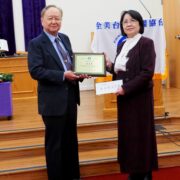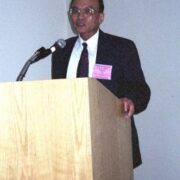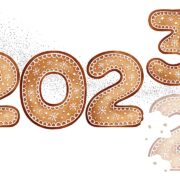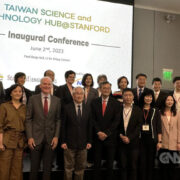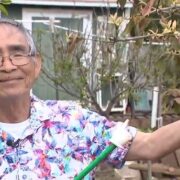懷念楊東傑醫師–台灣建國先鋒
Jay Loo(盧主義)

2016年在台北雙連教會慶祝3F 六十週年。右起: 劉重義 、盧主義、 陳以德、 楊東傑。圖/盧主義提供
楊東傑醫師於今年六月逝世,享年 99 歲。
1955 年 9 月上旬的一天晚上,楊醫師來到我住在費城天普大學醫學院附近的宿舍,因我們從未謀面過所以他向我介紹他自己。他在台南一中比我早九年,是應另一位台南校友的要求而來的。
然後,我們乘坐地鐵前往西費城,與三位在賓夕法尼亞大學攻讀研究院的台灣學生會面。
楊醫生是費城北郊阿賓頓紀念醫院的一名放射科住院醫師。陳以德和林錫湖在台南一中比我早三年與兩年。林榮勳是台北人,比我大五歲。陳以德和林榮勳正在學習國際關係,而林錫湖攻讀有機化學博士學位。
楊醫師和林榮勳比我早兩年來到賓大,一年後陳以德加入了他們。林錫湖和我那年秋天剛到費城。
之後、我們五個人幾乎每個週末都聚在一起,在唐人街或附近的餐館吃飯,飯後經常到林鍚湖 的公寓裡聊天。談話內容主要是發洩對國民黨政府腐敗和鎮壓台灣人民的憤怒。經過幾個星期的激烈討論,有一天我說我們繼續批評國民黨是沒有什麼結果的。為什麼我們不做點事來改善這種情況? “我們能做什麼?”林榮勳問,我脫口而出“我們可以鼓吹台灣獨立”。
之前,我在 1951年12月抵達明尼蘇達州聖保羅,就讀麥卡萊斯特學院。在那裡,我開始閱讀台灣的歷史和台灣的政治、經濟和軍事事務,包括弗雷德里格 “在中國國民黨統治下的台灣”、廖文奎 “台灣發言”(香港印刷出版社,1950 年)、喬治·科爾在 1947 年秋季刊《遠東調查》中關於 2 月 28 日事件的分析、杭立武的國民黨宣傳書《今日台灣》和美國政府刊物例如,美國對台灣經濟援助的報導。
楊醫師熟悉由廖文毅博士在東京發起的台獨運動。但台獨的概念對林榮勳、陳以德來說是陌生的。林榮勳問:「台灣怎麼可能獨立?我們不都是中國人嗎?」 「不,我們都是台灣人,我們不是中國人。」我回答說。然後我對他解釋,種族可以是國家認同的一個要素,但不是主要因素;一個民族的組成包含對祖國的熱愛、共同的政治經濟利益、共同的歷史記憶和對未來建設建全國家的渴望,我們效忠台灣,絕不效忠中國,因為中國是一個外國。
林榮勳又問:「可是《開羅宣言》不是把台灣交給了中華民國嗎?」我的回答是,宣言是一份新聞稿,沒有法律約束力,台灣的法律地位尚未確定;在舊金山和約中,日本放棄對台灣和澎湖列島的所有權,但沒有指定受益人,中華民國從未擁有台灣,中華人民共和國對台灣的主權主張沒有任何法律或歷史根據。
陳以德問道「台灣是一個小島,沒有多少資源。作為一個獨立的國家,它如何能生存?」我的回答,台灣人受過良好的教育、做人勤勞,台灣可以成為一個向世界出口製成品的繁榮國家,本也很小,受過教育的人口眾多,它正在蓬勃發展,台灣也可以一樣。
在這些討論中,我常遇到很大的阻力,因為林榮勳和陳以德比我年紀大,他們正在學習政治學,而我是一個不同領域的年輕醫學院學生,每當我們陷入僵局時,都是楊醫師來救援。他會說:「盧主義說的有道理。我同意他的看法。」楊醫師受到所有人的尊重,由於他据有虔誠基督徒的資歷和品格,楊醫師在保持我們團隊的和諧及凝聚力至關重要。

2006 年 7 月於 Lansdale, Pennsylvania 盧府相聚紀念 3F 五十週年, 前排左起: 陳以德、楊東傑 、盧主義 、Dolores Lin 、林錫湖,後排左:起:黃雪香 、邱義昌、 王傅文。圖/盧主義提供
12月,我提議成立一個我稱為台灣人的自由台灣(Formosas’Free Formosa, 3F)的小組,出版「時事通訊」在大約200名在美台灣留學生中倡導台獨,並尋求美國政府和媒體的支持。
除夕夜,我寫信給紐約時報主編,描述台灣人的困境和他們對自由的嚮往,並警告說,如果美國繼續支持國民黨的專制政權,台灣將容易受到中共的攻擊和吞併;這封信於 1956 年 1 月 11 日發表,極大地鼓舞了我們的小組織,此組織後來被稱為費城五傑。
3F 於 1956 年 1 月 1 日發動,主要是為了慶祝楊醫師的生日;兩個月後,廖文毅領導的台灣臨時政府於 1956 年 2 月 28 日在東京發表了「獨立宣言」。
3F於1958年1月1日改組為台獨聯盟(UFI),UFI於1966年成為全國性組織UFAI,全球性的台灣獨立聯盟(WUFI)成立於1970年1月,一直存在至今。
此事鮮為人知,但是,在北美第一個台獨組織「台灣人的自由台灣」的發起時,楊東傑醫師是關鍵人物,如果沒有他的積極支持和幫助,我無法說服林榮勳和陳以德加入 3F 小組。
1956 年夏天,楊醫師決定自Portland, Oregon 撘貨物船回台,當時我找到西部美國森林局的工作,準備到Idaho 州深山裏和一百五十大學生暑假打工,所以我們自費城駕車至西部的Oregon 州;那時我不會開車,楊醫師一人辛苦地橫行美國大陸,在 Pittsburgh, Chicago, 和North Dakota 的小村莊各停了一夜之外,每天駕使十幾個鐘頭的車。進入Nebraska 州之後公路兩邊,車開數個小時不見人蹤或房屋,令我深深感覺到美國土地之廣大。我不時與楊醫師交談,要不然他會因疲勞過度而入眠。
離開費城的第五天傍晚我們抵達Oregon 州的小鎮Pendleton,在那裏道別,楊醫師當夜去 Portland 港口上船回台。隔天我搭公共汽車去Idaho 州的森林局報到。
自1956 年我們分手之後,雙方斷絕音訊達四十年。1996 年我與妻子回台。(我於1951年、當時 19 歲時離台後事隔45 年後第一次回台灣。) 楊醫師專車到機場迎接,之後,帶我們去建國黨李鎮源主席辦公室交談,然後我們就在楊醫師在天母住家同一條街他的空房子住了數天;以後我們每次回台都去拜訪楊醫師伉儷,楊夫人做人誠懇溫柔敦厚、我們每次相聚總是非常快樂、滿心欣喜。
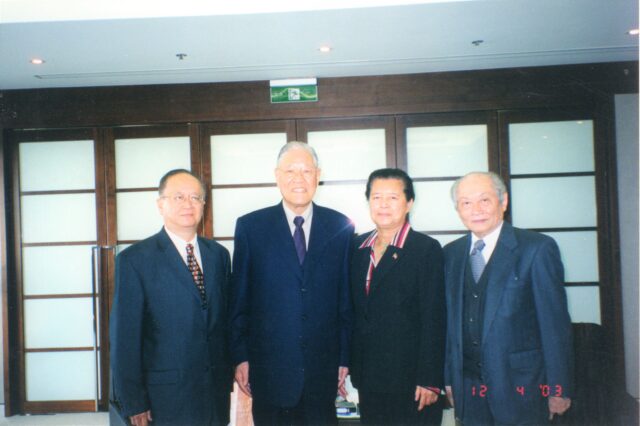
2004 年 5 月,筆者與楊醫師拜訪前總統李登輝在淡水的辦公室,並與李總統合影。左起:盧主義、李登輝、翁進治、楊東傑。圖/盧主義提供
2002年至2004 年我們回台拜訪前總統李登輝,與他討論台美關係,2003年 12 月以及 2004 年 5 月,我們邀請楊醫師陪同我們去拜訪李總統于淡水的辦公室,楊醫師在面會中給李總統報告有關當時建國黨的動態,李總統好客又建談、待人熱情、與他老人家交談實是一件快事;楊醫師與李總統同年生、同樣留學日本、他們很欣賞這些會談。
2006年7月,3F 及UFI的同志回到費城慶祝 3F 五十周年,楊醫師也自台北來參加;2016年劉重義在台北雙連教會主辦音樂會紀念美國台獨運動六十周年、會堂裏坐無虛席,許多參與太陽花活動的青年也來參加及協助,我與陳以德回台參加此盛會、楊醫師夫婦當然也出席。
楊醫師對建設自由台灣事業的奉獻從未減弱,晚年積極參與建國黨和以劉重義為首的台灣民族同盟的工作,楊醫師在90多歲時還時常參加街頭運動。
楊醫師從未從他的無私努力中尋求名聲或個人利益,他對台灣無畏的獨立倡導來自於他基督徒要幫助受壓迫的台灣人民的意顏;楊醫師的牙醫長子楊明昊也是一位為台灣的自由而孜孜不倦的戰士,他以組織為台灣遊「March for Taiwan (從費城的國家憲法中走到華盛頓特區的美國國會大廈) 」以紀念 1947 年三月台灣大屠殺而聞名。
海外台獨運動觸發了台灣內部的黨外反對運動,是台灣民主化的重要因素, 楊醫師過了有價值的人生,願他的榜樣鼓勵台灣年輕一代、努力維護台灣的自由並鞏固其民主制度。
楊醫師的故事煙沒無聞,但他的為人值得尊重和懷念;1955年秋天遇到楊醫師改變了我的人生軌道,一年後我放棄醫學(這是我第二次放棄學醫,第一次是我在台大念了一個月醫學院後即來美。) 改讀政治經濟,自此我大半人生致力於台獨運動。
我與楊醫師一樣、認為虔誠的基督徒不可以只在教堂裏祈禱而不顧社會上的不公不義。我們必須抵抗邪惡的政治、爭取自由、人權、為人類造福、如此才能心滿意足地活得快樂,Tom(楊醫師)是我心靈上的兄長,他是自由台灣之先鋒。
Remembering Dr. Tom Yang – A Taiwan patriot
By Jay Loo
Dr. Tom Yang passed away at age 99 in June.
One evening in early September 1955, Tom came to visit at my room near the Temple University medical school in Philadelphia and introduced himself. He was nine years ahead of me at Tainan First High School and he came at the behest of another alumnus from Tainan.
We then took the subway to West Philadelphia to meet three Taiwanese students pursuing graduate work at the University of Pennsylvania.
Dr. Yang was a radiology resident at Abington Memorial Hospital on the northern outskirts of Philly. Edward Chen and Echo Lin were three years and two years ahead of me at Tainan First High. John Lin was from Taipei and five years my senior. Edward and John were studying International Relations and Echo was pursuing a Ph.D. in Organic Chemistry.
Tom and John arrived at UPenn two years before me and Edward joined them a year later. Echo and I had just arrived that fall.
So the five of us gathered virtually every weekend, to share meals in Chinatown or nearby restaurants, often ended up in Echo’s apartment to shoot the breeze. The conversation was heavy on venting of anger at the Kuomintang (KMT) government’s corruption and repression of the Taiwanese people. After several weeks of heated discussions, one day I said it was not fruitful to keep criticizing the KMT. Why don’t we do something to improve the situation? “What can we do?” John asked, and I blurted “we can advocate Taiwan independence.”
To go back. I arrived in St. Paul, Minnesota to attend Macalester College in December 1951. While there, I started reading up on Taiwan’s history and the island’s political, economic and military affairs, including Fred Rigg’s Taiwan under Chinese Nationalist Rule, Joshua Liao’s Formosa Speaks (Graphic Press, Hong Kong, 1950), US Consul George Kerr’s witness account in fall 1947 issues of Far Eastern Survey of the massacre of 30,000 unarmed Taiwanese civilians by Chiang Kai-shek’s troops in March that year, KMT propaganda tome Taiwan Today by Han Li-wu, and US government publications, e.g., reports on US economic aid to Taiwan.
Tom was familiar with the Taiwan independence movement started by Dr. Thomas Liao’s group in Tokyo. But the concept of Taiwan independence was new to John Lin and Edward Chen. John asked: “How can Taiwan become independent? Aren’t we all Chinese?” “No, we are all Taiwanese. We are not Chinese.” I then explained. Race can be an element of national identity but it is not the dominant factor. What constitutes a nation group is the love for the homeland, common political and economic interests, shared historical memories and the desire to build a grand nation in the future. “We owe our allegiance to Taiwan, never to China, which is a foreign country.”
John again. “But didn’t the Cairo Declaration give Taiwan to the Republic of China?” My answer was that the Declaration was a mere press release, which was not legally binding. Taiwan’s legal status was undecided. In the 1951 San Francisco peace treaty, Japan gave up its title to Taiwan and the Pescadores but no beneficiary was named. The Republic of China never gained title to Taiwan. China’s claim of sovereignty over Taiwan lacked any legal or historical ground. Under the UN Charter, the people of Taiwan have the right to determine their own future peacefully and without outside coercion.
Edward queried, “Taiwan is a small island without much resources. How can it survive as an independent nation?” My answer: “Taiwanese are well educated and industrious. Taiwan can be a prosperous nation exporting manufactured goods to the world. Japan is also small and has a large, educated population. It is thriving. So can Taiwan.”
In these discussions, I ran into much resistance because John and Edward were older and they were studying political science while I was a young medical student in a different field. Whenever we ended up in a stalemate, it was Tom who came to the rescue. He would say “What Jay says makes sense. I agree with him.” Since Tom was respected by all of us, due to his seniority and strength of character as a devout Christian, Tom was essential in keeping the harmony and cohesion of our group.
In December I formally proposed to form a group which I labeled Formosans’ Free Formosa (3F) to advocate Taiwan independence among some 200 Taiwanese students in the US through a newsletter, and to seek the support of US government and media. On New Year’s Eve, I wrote a letter to the editor of the New York Times, describing the plight of the Taiwanese and their yearning for freedom and warned that if the US continued to support the repressive KMT regime, Taiwan will become vulnerable to Chinese communist annexation. The letter was published on January 11, 1956, and was a great encouragement to the group, later to be known as the Philadelphia Five.
So, 3F was launched, effective January 1, 1956, in part to celebrate Tom’s birthday. Two months later Thomas Liao’s provisional government of the Republic of Taiwan issued a Declaration of Independence in Tokyo on February 28, 1956.
3F was reorganized as United Formosans for Independence (UFI) on January 1, 1958. UFI became a nationwide organization UFAI in 1966. The global World United Formosans for Independence (WUFI) was founded in January 1970, which exists to this day.
It is little known. But Dr. Tom Yang played a pivotal role in the launching of Formosans’ Free Formosa, the first Taiwan independence organization in North America. Without his active support and help, I would not have been able to persuade John and Edward to join the 3F group.
In the summer of 1956, Dr. Yang decided to board a freight ship at Portland, Oregon and return to Taiwan. At the same time, I found a job with the U.S. Forest Service, working with 150 college students for the summer. So we decided to drive from Philadelphia to Oregon. I didn’t know how to drive then, so Tom drove across the U.S. continent without my help. Except for one-night stops at Pittsburgh, Chicago and a village in North Dakota, Tom drove over ten hours each day. After entering Nebraska, we did not see any people or houses along the highway for several hours. I was really impressed by the vastness of the United States. I had to keep talking to Tom, lest he fall asleep at the wheel from sheer exhaustion.
On the fifth day after leaving Philadelphia, we arrived at the small town of Pendleton, Oregon at dusk, where we bade farewell. Tom continued on to the Portland harbor to board the ship. Next day I took the bus to the Forest Service camp in Idaho.
After parting company in 1956, Tom and I had no contact for forty years, since Taiwan was under martial law, the reign of terror which lasted thirty-eight years. In 1996, I returned to Taiwan with my wife Helen. I left the island at age 19 in 1951, so this was the first visit after an absence of forty-five years. Tow hired a limousine and came to the airport to welcome us. Then he took us to the office of Taiwan Independence Party Chairman, Professor Li Tin-guan for a chat. We then spent several days at Tom’s vacant rental apartment, which was on the same street as Tom’s residence in Tenmu.
Each time we visited Taiwan thereafter, we always called on Tom and Mrs. Yang, who was a warm and gracious hostess. We treasured these visits – each occasion was a sheer delight.
From 2002 to 2004, Helen and I met with former President Lee Teng-hui to discuss U.S.-Taiwan relations, for an hour and a half each time. Lee was Taiwan’s first popularly elected president who scuttled much of the Kuomintang’s party-state legacy and made Taiwan’s government more democratic. In December 2003 and May 2004, we invited Tom to join us on these visits to President Lee’s office. Tom briefed President Lee on recent activities of the Taiwan Independence Party. Since Tom and President Lee were both born in 1923, and both studied in Japan, they relished the conversation. President Lee was hospitable, knowledgeable and voluble but also an attentive listener. It was delightful to chat with him.
In July 2006 the old comrades of 3F and UFI returned to Philadelphia to celebrate the 50th anniversary of 3F. Tom came from Taipei to join us. In 2016, Ted Lau, an old friend, organized a concert at Taipei’s Sianglen church to commemorate the 60th anniversary of the Taiwan independence movement in the United States. The 600-seat hall was filled to the brim. Edward Chen and I returned to Taiwan for the occasion. Dr. and Mrs. Yang also attended.
Many young participants in the Sunflower movement came to help manage the event. (In the Sunflower movement of 2014, hundreds of college students occupied Taiwan’s legislature for twenty-three days, caused an island-wide uproar of support, and succeeded in halting the implementation of the KMT-sponsored Cross-Strait Service Trade Agreement.)
Tom’s dedication to the cause of Taiwan’s freedom never waned. In his later years he was active in the affairs of the Taiwan Independence Party and the Taiwanese People’s Congress led by Ted Lau. He participated in street rallies well into his 90’s.
Tom never sought fame or personal gain from his altruistic endeavors. His fearless advocacy for Taiwan came from his Christian aspiration to help the oppressed Taiwanese compatriots. Tom’s dentist son Michael is also a tireless fighter for Taiwan’s freedom. He is best known for organizing the “March for Taiwan” (hiking from the National Constitution Center in Philadelphia to the US Capitol in Washington, D.C. to commemorate the March massacre of 1947).
The overseas Taiwan independence movement stimulated the pro-democracy opposition movement inside Taiwan and is an important factor in Taiwan’s democratization. Dr. Yang lived a worthy life. Hopefully, his example will encourage Taiwan’s younger generation to preserve Taiwan’s freedom and solidify its democratic system.
Dr. Yang’s life is worthy of respect and remembrance. The encounter with Tom in the fall of 1955 changed the trajectory of my life. A year later I abandoned my medical studies, went back to the University of Minnesota to major in political science and macro-economics. In April 1958, a condensed version of my summa cum laude graduation thesis was published in Foreign Affairs (“The China Impasse: A Formosan View”). From then on, I spent much of my life striving for a free and independent Taiwan. Like Tom, I believe a devout Christian cannot just pray inside the church and disregard injustice in society. We need to resist autocracy, fight for freedom, human rights and try to improve the lot of mankind. One can then live meaningfully and joyfully. Tom was my soul brother. He was a vanguard of free Taiwan.
Source from: Jay Loo(盧主義)、民報
Posted on 08/30/2022
Edited on 10/30/2022

